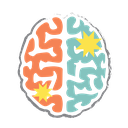

This activity will help participants understand the colours that make up light and how humans visually perceive the colours of objects.
Materials
- Paper plate
- Pencil
- Ruler
- Markers (red, orange, yellow, green, blue, purple)
- String/yarn
- Scissors
Framing
What do you get when you mix together every colour of the rainbow? Most participants will likely say brown, grey, or black, and they’re not wrong, because they’re thinking about mixing tangible things together, like paint. Explain to the participants how you can make the colours turn white. They will be intrigued to find out how.
Instructions
- Divide the paper plate into six even sections using the ruler. Colour each section one of the colours of the rainbow, then cut off the excess paper plate, so only your coloured circle remains.
- Use the pencil to punch two holes in the plate, about 1 cm from the centre. Take 3-foot piece of string and thread it through one hole and back through the other hole. Gather the ends of the string and tie into a knot.
- Take the knotted end of the string in one hand and the looped end in the other hand. Wind up the circle by twirling it away from you, as if turning a jump rope.
- When the string is tightly twisted, pull your hands apart and away from the circle, and watch as the colours disappear.
Modify
- Try this activity using two of six colours. What do you think will happen?
- Now that we’ve combined colours into white, let’s separate them: Place a sheet of white paper on a flat surface in front of strong sunlight or a flashlight that emits white light, and then place a glass prism on top of the paper. Rotate the prism around until a rainbow is cast on the paper. Check out Make Your Own Rainbow Science Experiment for other ways to make a rainbow.
Safety
- It may best to have the adult facilitator punch the hole in the paper to minimize any injuries.
Wrap-up
Sunlight and white light is made up of all the colours of the rainbow. When we look at something and perceive it to be a certain colour, it’s actually that that thing has absorbed every colour in the rainbow except the one we see it to be; that colour has been reflected back into our eyes. When we spin the circle really fast, it becomes difficult for our brains to see each colour and so the colours mix together and “disappear”, (Enhanced: the glass prism bends the light in such a way that the light separates into the colours of the rainbow).
- Fun fact: While the primary colours for painters are red, yellow, and blue, for computer programmers and web coders the primary colours are red, green, and blue (RGB).
Adriana. “Color Experiment For Kids.” Educational Toy Factory: Building Brighter Futures One Child at a Time. Last updated September 6, 2016. Retrieved May 22, 2018, online from: https://www.educationaltoyfactory.com/color-experiment-for-kids/